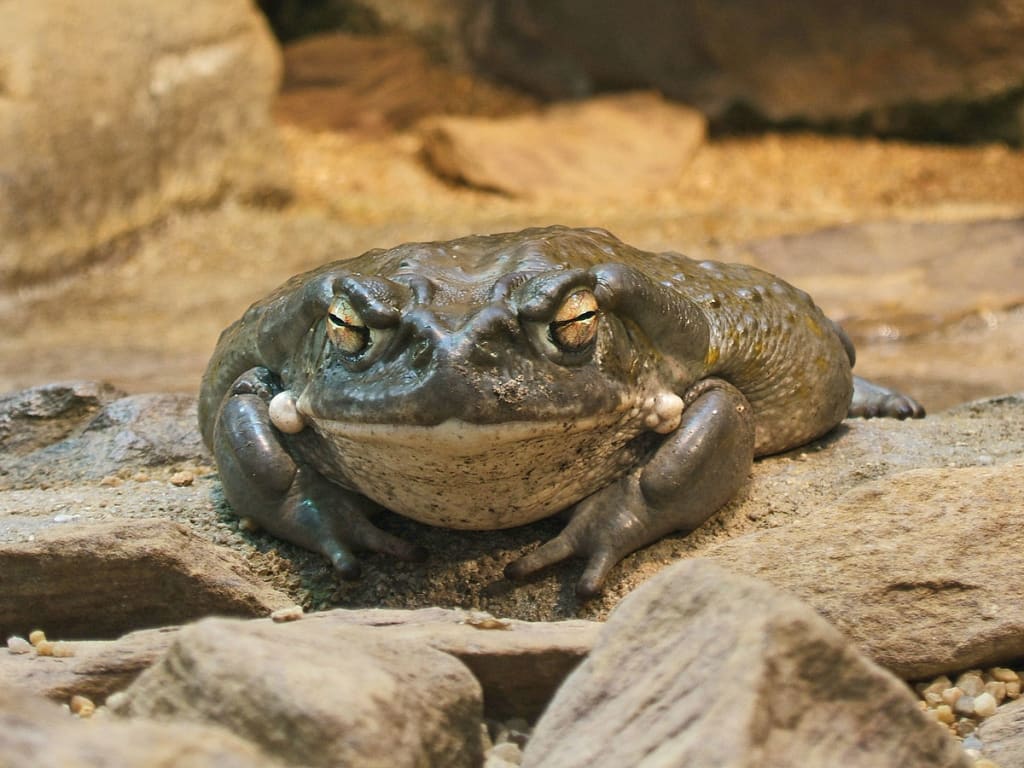Stop Licking This Toad
Recently, the National Park Service issued an unusual notice requesting that visitors refrain from licking toads.

“As we say with most things you come across in a national park, whether it be a banana slug, an unfamiliar mushroom, or a large toad with glowing eyes in the dead of night, please refrain from licking,” the agency stated.
The report posted on Facebook specifically applies to the Sonoran desert toad, also known as the Colorado river toad.
“These toads have prominent parotoid glands that secrete a potent toxin,” the agency wrote. “It can make you sick if you handle the frog or get the poison in your mouth.”
Visitors seek like the toad for something else it secretes: a hallucinogenic substance known as 5-MeO-DMT.
While the secretions of the toad can lead to a trip, the National Capital Poison Center notes it can also “cause severe irritation, pain, and tissue damage.” A lick or two can cause “numbness of the mouth and throat as well as severe and life-threatening effects on the heart.”
The agency stated: “These effects include irregular rhythm of the heart, heart block, reduced blood pressure, and cardiac arrest. These severe effects can also occur after absorption through the skin.”
NPR reports that many toad users do not really lick the amphibians, but rather smoke their secretions. In New Mexico, the toad is currently deemed endangered due in part to "overcollecting" by individuals seeking these mind-altering secretions.

The New York Times reported earlier this year that the toad's population is in danger of collapsing due to the demand for its secretions.
Boxing legend Mike Tyson is one of the toad's enthusiasts.
“The toad’s whole purpose is to reach your highest potential,” he told the New York Post last year, saying he first tried it as a dare when he was a “wreck” but has since improved.
“In my trips I’ve seen that death is beautiful. Life and death both have to be beautiful, but death has a bad rep.”
“The toad has taught me that I’m not going to be here forever,” he said. “There’s an expiration date.”
According to the National Park Service, the toad is approximately 7 inches long, making it one of the largest in the country, and emits a "weak, low-pitched toot, lasting less than a second."

Hallucinogenic Plants
Mankind has utilized hallucinogenic plants for thousands of years. Diverse species with hallucinogenic qualities were and continue to be integral part of the culture and religion of both primitive tribes and advanced civilizations.
Later on, hallucinogens have become a part of popular culture, serving as illicit and frequently hazardous forms of amusement. Their extensive use as stimulants causes several social issues and a growing interest in the field of research, primarily due to their negative side effects.
Their effect on the human body, particularly the central nervous system, provides a path for the development of new, promising medications.
In Mexico, Indian tribes ingest mescaline, a psychedelic contained in the peyote cactus, religiously. The potent effects of this plant caught the attention of ethnographer James Mooney, who participated in a Sioux Indian rite.

In 1890, a chemist from Leipzig was able to create a synthetic form of mescaline. Numerous artists utilized the drug to increase their creative capabilities.
Synthetic Psychedelic
In 1938, while working for Sandoz Chemical and attempting to manufacture a blood circulation stimulant, the Swiss chemist Albert Hoffman produced LSD, a modern psychedelic.
Following the twenty-fifth experiment, he synthesized LSD, which he designated LSD-25 because it was not the desired substance. He kept the formula a secret for five years, until 1943, when he accidently exposed himself to it and wrote about the experience he had.
“uninterrupted flow of fantastic images, extraordinary and intense shapes, a play of colours as in a kaleidoscope.”
After three days, he repeated the experiment, but this time on purpose; however, the dose was overly high, and he characterized the experience as terrifying. Hoffman shared his findings with other Sandoz researchers and began testing the medication with lesser doses of extraordinary potency.

Then, testing revealed its potential as a treatment for psychiatric disorders. In 1949, American researchers started utilizing it to simulate mental disorders for psychotherapy and alcoholism treatment.
Negative publicity contributed to the discrediting of its usage as a medication by 1980 due to mounting evidence of its toxicity, which began to emerge in 1967. In early 1990s, it began to be used in nightclubs, music festivals, and parties as a "club drug."
Do not hesitate to read: Neerja Bhanot: The World's Bravest Flight Attendant in History
About the Creator
Rare Stories
Our goal is to give you stories that will have you hooked.
This is an extension of the Quora space: Rare Stories
X(formerly Twitter): Scarce Stories
Official Bookstore: davidkellertruecrime
Writers:
....xoxo






Comments
There are no comments for this story
Be the first to respond and start the conversation.